Double Down.
Posted on | August 27, 2014 | 1 Comment
Every year I make the same exact mistake. In January I carefully make diagram after diagram of the summer garden. I arrange the plants, move the beds, build trellisses, and make compost heaps. All on paper. Because these things are much easier to move on paper than they are in real life. I especially consider the gradual turning under of the summer garden—a process by which the pigs root up and mix all the withered plants, the mulch, break-through weeds, and and a new batch of barn manure to prepare beds for fall planting.
Ideally, the garden beds are arranged so that the first crops to fail are grouped together (first the peas and carrots, then potatoes and onions, followed by the lettuce and brasscias, eventually the zucchini and summer squash, etc, etc). So the pigs can be contained in a movable pen placed over one bed filled with spent, browned, exhausted crops and then quickly and easily slid over to the next bed. That way the garden gets turned in a nice orderly procession and the pigs are kept away from tempting crops that are still producing.
But somehow, between January’s perfectly arranged diagram and the fall planting in September, all chaos breaks loose. Perhaps it happens when I start squeezing extra transplants from the greenhouse into any space available. Or maybe it gets thrown off when I find a new variety in the garden store that I absolutely have to try so I add or extend a bed to fit it in. Could be last minute reshuffling to accommodate all those confusing companion planting or crop rotation charts. Might even be the alarming tendency for plant rows to be mislabeled or left unlabeled because I had to rush off to pick someone up from sports practice, or stop to chase down an escaped goat, or spotted a snake slithering through the mulch and couldn’t really tell whether it was an Eastern hog snake or a copperhead so garden activities had to be canceled for the day. Regardless, by the time I return to the garden I often have trouble remembering what seeds I planted where and I end up overseeding or simply seeding in a different spot than I had planned. Garden charts just don’t account for snake sightings.
When the summer heat broke and we experienced our first morning in the 60’s, I stood in the garden considering fall plantings and surveying the damage. Yep. A random assortment of garden chaos. With tomatoes flourishing next to overgrown lettuce beds, decayed zucchini next to sprawling pumpkin vines, almost-ripe watermelons trellised over the remains of the onion crop. It looked like the pigs would have another year of forgoing a convenient 16 X 8 rectangle pen of cattle panels for an arbitrary assortment of trapezoids, parallelograms, and rhombi. These would be patched together with scrap panels and designed to put the pigs over the crops that need to be turned under, but at least a snout distance away from the thriving peppers, eggplants, tomatillos, and melons.
Except this year I made another mistake.
That’s right, people, a double down on the garden failures.
This year, I don’t have any pigs.
Last year’s pigs were so big that we’re still working our way through their tenderloins, shoulder roasts, and hams. So we didn’t bother to get a spring piglet. Which was a shame when the farm was producing the extra foodstuff favorites of pigs. It was disappointing to pour out extra goat milk, toss a discovered nest of hidden chicken eggs (therefore, of an unknown age, undetermined developmental status, and inedible by humans), or eat every single last piece of crookneck squash ourselves, but it was really depressing now.
We don’t till in our garden and yet I was facing off with this:
Enough to make a farmer cry tears in her bacon.
Luckily, I own way too many animals a diversified farm operation. Pigs aren’t the only crop-grazing, dirt-tilling critters around here. (Although they are the most delicious ones.) The chickens were my next best bet for turning under the garden. They’ll eat the majority of greens and even what they won’t eat they will trample down or scratch up by the roots. They love digging through mulch and soil for grubs and bugs and create light fluffy, perfectly mixed piles of compost. Sure, the raised beds would have to be reshaped after the chickens flung the contents around, but reshaping light, loose debris with a pitchfork is a whole lot easier than turning the soil with a shovel, hoeing the remaining weeds and clods, and then leveling with the iron rake. A whole lot easier.
Too bad the pen creation wasn’t as easy. Because chickens need one thing that pigs really don’t.
Predator protection.
The garden is surrounded by an 8′ fence to keep out critters. But that fence is made of chain link which is easily scaled by the opossums and raccoons that feast on unprotected chickens around here. Our chickens had to be secured at night if they were going to be separated from the livestock guardian dogs and placed in the garden.
Good thing I still had a chicken tractor in the garden. Kind of.
What I had was an 8 year old chicken tractor. Which worked fine when I got my first 4 chickens. Those chickens were moved merrily around the farm, enjoying fresh grass and bugs every day and the security of a locked coop every night. Of course, I only used the chicken tractor in that capacity for 1 year. Chickens, being like potato chips, are way too addictive to have just 4 of them. I mean, have you ever only had 4 potato chips??? Unless the kids only left 4 potato chips in the bag. Or worse, they left just enough dregs of chips to equal 4 full chips if you tip the bag and funnel those dregs directly into your mouth. Not that I’ve ever done that….
So by the next year I had a substantial flock of chickens. Too substantial for a movable pen so they had to have a permanent stationary coop. Since they had a permanent stationary coop, we had to let them free range to get the healthiest chickens with the healthiest eggs. Once they were free ranging we had to put up a fence to keep loose dogs and daytime predators out of their pasture. Once we had a pasture there was no reason not to fill that pasture with other critters like ducks and goats and sheep and pigs and ponies. As soon as that pasture was full of critters, it only made sense to get a livestock guardian dog to guard all those critters. And then that livestock guardian dog needed another livestock guardian dog as a friend. Because, really, can you imagine the pressure of all that responsibility?
Yes, I know. That’s kind of the equivalent of looking at the potato chip bag with its pathetic chip dregs and saying, “Screw it, who wants to go to Walmart for another bag of chips?” And then coming home with 4 full bags of chips—sour cream and onion, salt and vinegar, barbecue, and ridged.
Please. You know you’ve done that, too.
Anyway, the chicken tractor got demoted. Initially it was used in the barnyard for hens with newly hatched chicks. Then we built a brooder room in the barn. So it was moved down to the garden for the guineas. The guineas did a decent job of eating garden bugs without destroying the veggie plants. But they were too loud for the neighbors. So the chicken tractor became an excellent garden shelf to set tarps and row covers when not in use, to stack all varieties of sprinklers, spray nozzles, and hose connectors, and to hold rolls of bed edging. Plus, a place to stash rocks where they were out of the way of the lawnmower but available for holding down paper mulch or hammering in garden stakes.
The downside of the chicken tractor being used as garden shelving was that it hadn’t been moved for about 6 years. And as I assessed it’s chicken holding capacity, I realized there was no way it was moving ever again without falling completely apart. Which meant that if I wanted to use it to protect the chickens as they turned over the summer garden, it had to stay in place. The fencing had to come to the chicken tractor.
Combining the immobility of the chicken tractor with the haphazard arrangement of the beds to be turned over, I figured trapezoids, parallelograms, and rhombi were a pipe dream. Heck, quadrilaterals seemed unlikely altogether. I gathered a variety of cattle panels, fencing rolls, PVC pipes, rebar, tarps, shade cloth, hay twine, and set to work. I ended up with a decent straight stretch over the squash.
The rest of the pen was a free for all. Where I ran out of cattle panel, I used some flexible plastic netting. Even though I could have easily cut the netting with scissors, I didn’t bother. It would easier to roll it back up on the roll when I was done with the pen if I left it in one piece. Besides, the intact roll added a little extra support to the wobbly PVC pipe post.
If the panel or fencing had squares that a chicken could squeeze through, I attached some of the garden edging. I also left that on the roll instead of cutting it. For the same reasons as above. Plus, cutting wire is so successful at creating sharp ends that poke me despite my best efforts to avoid injury that my hands and legs start to spontaneously bleed whenever I get out the wire cutters. Just to get it over with already.
When I ran out of cattle panels, fencing, and edging, I just started making do. One section of the pen was created with an unused utility gate with the gaps covered by a trap, some shade cloth, and a scrap piece of field fencing.
Tractor Supply and Southern States can claim whatever they want. But “For Life Out Here,” whatever is laying around the farm works just fine “For Those Who Do.”
I hung a piece of shade cloth for lounging under in the heat of the day.
I used some bamboo garden stakes to add extra roosts to the chicken tractor and I set the water trough right beside it to discourage the chickens from hopping onto the roof of the tractor and then hopping out of the pen. I knew the chickens were capable of getting over the few 3′ tall sections of cattle panel but I hoped they had an incentive to stay in (lots greens and bugs) and no reason to get out (chickens hate to be separated from rest of the flock).
Overall, it was a success. What the pen lacked symmetry, it made up for in purpose. If it’s durability was in doubt, that just made it easier to take down when the job was done. If the design was indecipherable, that just meant it would be harder for the chickens to find their way out. After all, several times as I tied fencing to posts and attached shade cloth or garden edging, I found myself trapped inside the perimeter or wandering the outside of the fence trying to get back in to where I had been working. If I couldn’t find my way out, surely the chickens couldn’t either. Probably. Maybe.
Then in went the chickens. I chose 8 of the older hens plus Michael, the less dominant rooster. I added a couple sheep to help with weed control. Although the sheep’s role in the garden was short-lived. (Flexible plastic netting and PVC pipes might hold chickens. But they don’t hold sheep.)
Now I’m just letting the chickens prepare the fall beds while I prepare to can tomatoes and pickle peppers. In between rescuing the couple chickens that fly out of the pen, then pace the fence, frantically looking for a way back in.
Oh, the mind of the chicken is unknowable, Grasshopper. Completely unknowable.
Comments

One Response to “Double Down.”
Leave a Reply
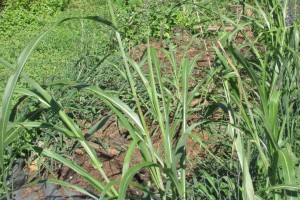
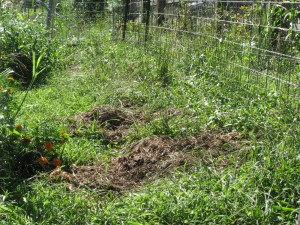
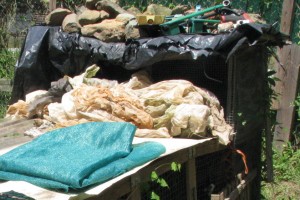
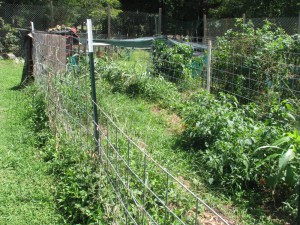
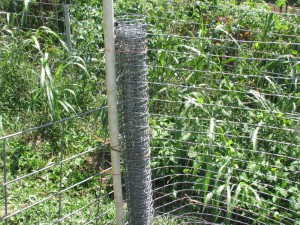
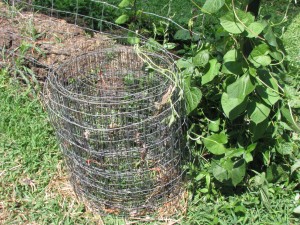
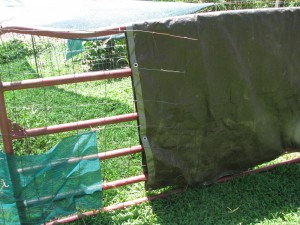
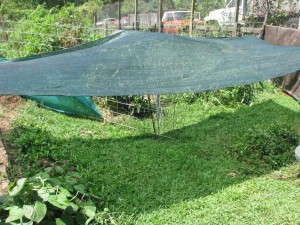
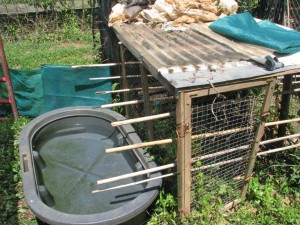
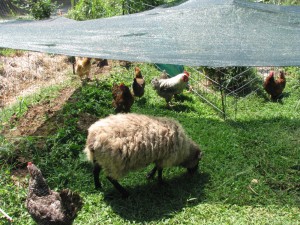
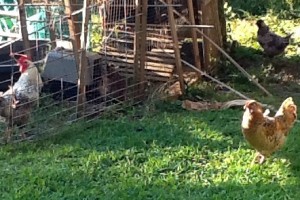




August 29th, 2014 @ 10:11 am
Why did Rube Goldberg come to mind as I read this?